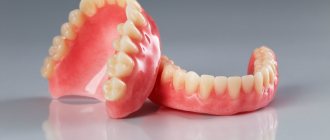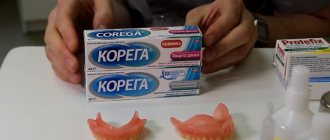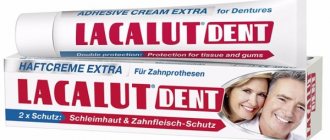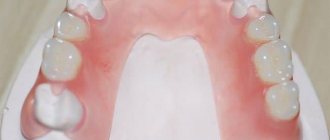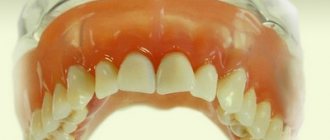What is a clasp prosthesis?
Clasp dental prosthetics is a widely used treatment method in orthopedic dentistry. Designed to restore teeth in both the lower and upper jaws. The name itself comes from the German “bugel”, which means “arc”, that is, bugel - literally “having an arc”. The design of clasp dentures includes a metal or plastic arch, artificial teeth that are attached to a base that imitates gums, and fixing elements in the form of hooks, clasps or crowns.
Stages of making a clasp prosthesis
Based on the principle of making the frame, the clasp prosthesis is divided into several types: soldered, solid-cast, milled, and based on laser sintering of nanoparticles of a special metal alloy powder. The last two methods are considered the most progressive and allow you to create a high-precision (up to 10 microns) and comfortable design.
Manufacturing takes place in 4 stages:
- first the dental technician creates a plaster model
- Based on the plaster model, a prototype of the prosthesis is cast and scanned
- using the scan, the frame of the clasp structure is modeled on a computer
- the prosthesis is ultimately sintered or milled.
The result exceeds all expectations - the prosthesis fits tightly to the gums and teeth, does not break and looks very aesthetically pleasing.
Price
The price of the prosthesis depends on what material was used in its manufacture, on the complexity of the technician’s work, and on the individual design features. In any case, our prices are acceptable for any person with average income.
The Denta Labor dental laboratory offers services for the production of locking clasp dentures, as well as other types of dentures and implants. You can consult with a specialist and find out prices for services by calling in Moscow (495) 162-08-25.
Indications for clasp prosthetics
The main indication for clasp dentures is the inability to install dentures on implants and the presence of at least several supporting teeth to which it could be secured. Partial structures are most often used both to replace several teeth with terminal defects and to restore a single tooth.
Whereas the clasp upper and lower denture completely reproduces the entire dentition. In addition, there is a splinting clasp prosthesis, which is used as a structure that restores and supports teeth. The prosthesis splints teeth affected by periodontitis or periodontal disease from the inside, replaces missing parts of the dentition and prevents the occurrence of adentia and prolongs the performance of the affected teeth.
Contraindications include:
- oral diseases in the acute stage
- increased tooth wear
- diseases leading to bone loss
- low or missing abutment teeth
- deep bite
- chronic neurological and mental diseases
- short frenulum of the tongue
- shallow floor of the mouth
- allergy to metal or other materials used in the design
Pros and cons of clasp prosthetics
This type of replacement structure is the pinnacle of removable prosthetics. On the one hand, it can be used to restore a large number of lost teeth. On the other hand, even in difficult cases (for example, two teeth are missing in front, three on the right, and five on the left), this is still a light and comfortable prosthetic system.
The following are responsible for comfort during clasp prosthetics:
- a very thin arch that presses tightly against the palate when worn;
- reliable fasteners providing rigid fixation.
Thanks to this, the prosthesis does not play during conversation, chewing and is practically not felt by the patient. This is a truly reliable type of prosthetics.
The main advantages of clasp dentures
- Functionality. A rigid type of fixation with support not only on the gums, but also on the teeth, completely restores chewing function.
- Strength. The presence of a metal frame makes it possible to install prosthetic teeth even with severe violations of the integrity of the dentition.
- Hygiene. Depending on the type of fixation, clasp dentures are removable and conditionally removable. Some are easy to clean at home, while others can be cleaned during hygienic cleaning at the dental clinic.
- Durability. Durable modern materials and uniform load distribution make the prosthesis reliable, allowing it to be used for 5–10 years.
- Aesthetics. Correct selection of the shade of the polymer base and dental crowns makes the artificial part indistinguishable from the patient’s own teeth. Options with attachments, telescopic crowns and thermopolymers are invisible in the smile area.
- Bioinertness. Thanks to titanium, as well as modern thermoplastics, replacing lost teeth does not harm the body. The materials are hypoallergenic and do not interact physically or chemically with the oral environment. This means that the taste sensations are completely preserved.
- Convenience. The minimal size of the prosthesis (thin arch and only one layer of polymer) allows you to not feel it when wearing it, does not affect diction, does not cause discomfort or a gag reflex, so the prosthesis can be worn around the clock.
- Splinting. This type of prosthetics can be used even with loose gums and loose supporting teeth. Adding special splints to the frame will help keep the supporting teeth in the desired position, prolonging their life.
- Maintainability. In most cases, a prosthesis can be repaired if it breaks. Only some types of fasteners cannot be restored.
The production technology has been worked out to the smallest detail, and is optimal in terms of price and time. This is also an important advantage.
Disadvantages of clasp dentures
- High price. If we compare the clasp with a conventional plate prosthesis, the difference in price attracts attention. It is formed taking into account complex manufacturing technology and the use of expensive materials. This cannot be considered a real disadvantage, because better quality means additional comfort and aesthetics, as well as 2-3 times longer service life.
- Grinding teeth for crowns. In some cases, it may be necessary to prepare healthy tissue and remove the dental nerve to form a support.
- Not used for edentulous patients. In case of complete absence of teeth, our dentist will offer more cost-effective prosthetics using All-on-4 implants.
Cheaper options have additional disadvantages, including the effect of galvanization and allergies to metal, discomfort for 1–2 weeks during the adaptation period, less aesthetics of fasteners, as well as bone resorption, which can only be avoided by prosthetics on implants.
Types of clasp dentures
Clasp dentures are also divided according to the method of their attachment to the supporting teeth. Unlike completely removable structures, which are fixed by suction to the gum or using special adhesives, fixation and installation of clasp dentures occurs using several types of fastening.
On clasps
Clasp dentures with clasps consist of metal hooks that clasp the abutment tooth in the neck area. The clasp clasp prosthesis is attached without grinding down the enamel, provided that the supporting teeth are not destroyed or affected by severe caries. However, this type is not aesthetic enough - the hooks are noticeable when you smile.
On locks or attachments
A locking clasp prosthesis consists of two parts, one of which is attached to the ground abutment teeth, and the second with the help of locks to the prosthesis itself. Unlike other types, a clasp denture with attachments is more immobile, so the load is distributed evenly on the supporting teeth and the alveolar mucosa.
Clasp prosthesis on telescopic crowns
When installing a clasp prosthesis on telescopic crowns, first fixed metal crowns are placed on the supporting teeth, and then ceramic crowns are placed in the prosthesis.
Design development
Like most types of prosthetics, the manufacture of a clasp prosthesis consists of two stages: preparation for installation and production of the structure.
It all starts with a thorough diagnosis of the patient’s jaw. The initial examination is complemented by an x-ray examination, which determines the condition of the teeth and root canals. It also shows the presence of pathologies in both jaws. In more complex cases, EspaDent clinic specialists use a modern 3D tomograph with layer-by-layer images of the jaw. During the diagnosis, the doctor also checks for allergic reactions to the materials used. Based on the clinical situation, wishes and capabilities of the patient, the dentist selects a suitable prosthesis.
The preparatory stage for installing a clasp prosthesis includes:
- Sanitation (cleaning) of the oral cavity.
- Elimination of carious cavities and inflammatory processes in supporting teeth.
- Grinding of teeth and fixation of crowns (for locking and telescopic structures).
Treatment of supporting teeth can cause discomfort, so the procedure is carried out using local anesthesia - safe and painless.
In order for the dental technician to begin making the partial denture, the doctor takes impressions of the prepared jaw. Then follows the calculation part, on the basis of which the specialist creates a wax model of the clasp. The sample is used to produce a metal arch onto which a temporary base and new teeth are installed.
The intermediate product is given for fitting. The patient evaluates the convenience of the design, the reliability of fixation in the oral cavity, and the level of comfort when moving the jaw. If necessary, the prosthesis is adjusted and then the final version is made. In the production of the base, artificial gum, plastic or nylon is used.
After installation, the doctor gives recommendations on how to care for the product. The process takes 3-4 weeks. The time frame may extend due to the need for preliminary dental treatment.
Design nuances for both jaws
The structure of the prosthesis depends on the installation site. For example, a clasp denture is installed on the upper jaw using locks and clasps (hooks). The first method is more popular because... In addition to fixation, the locks provide high-quality support during chewing loads. The hidden fastening mechanism of lock-type prostheses ensures high aesthetics and does not interfere with eating.
Indications for installing a prosthesis on the upper row is the impossibility of implantation. And also the so-called “flat palate” syndrome - atrophy of the alveolar processes.
Unlike the upper row, the clasp denture on the lower jaw can be attached in any of the available ways. The difference between the designs is the location of the arc and fixing elements. In an upper denture, the arch may be located in front or in the middle of the palate. There is also a difference in the shape of the arc: in the form of a jumper, a ring or a crescent.
Nylon clasp quadrotti prosthesis
A product of the Italian company Quattro Ti, the quadrotti clasp prosthesis is very similar to a removable nylon prosthesis, with the only difference being that during its manufacture, nylon is mixed with hypoallergenic plastic. The resulting material has a number of advantages: it is more durable than nylon, and artificial teeth do not show through it. According to the manufacturers, this type of metal-free clasp prosthesis does not deform over time, does not cause discomfort when worn, and looks much more aesthetically pleasing than other prostheses. A soft prosthesis is attached to the teeth using plastic clasps, or saddles, covered on top with the same material as the base of the prosthesis. Saddles can be either pink or white, making them unnoticeable on the teeth. As for the disadvantages of the prosthesis, firstly, Quattro Ti is not strong enough, since no matter how strong the plastic is, it cannot be compared with metal. Secondly, a clasp prosthesis with nylon saddles requires special care using special means, which requires additional costs and cannot be repaired.
Caring for clasp dentures
Getting used to the clasp denture may take a couple of days. At first it will be somewhat uncomfortable for you to talk, so you will have to get rid of speech defects with the help of special exercises. Eating will also cause some difficulties. At first, to minimize pain, it is best to divide food into small portions and exclude very hard foods and sticky sweets from the diet. In order to quickly get used to the prosthesis, do not take it off at night.
Twice a day (morning, evening) it is necessary to remove the clasp prosthesis and clean it of plaque using the means recommended by the doctor, and also rinse it in a special antibacterial solution.
The clasp denture should be stored in a container, but not in water. Some types of structures, for example, soft quadrotti dentures, require special care, otherwise they fade and look unsightly on the teeth.
Advantages and disadvantages
For comparison, let’s take the clasp’s “classmates” - fixed bridges and removable plate prostheses. Clasp orthopedic structures, of course, are superior to plate ones in strength, but, like bridges, they are a temporary way to restore the dentition. Despite all the efforts of manufacturers, the clasp is not able to stop the loss of bone tissue, the inevitable decrease of which soon leads to changes in facial features and disturbances in the functioning of the dental system and internal organs. The obvious disadvantages of a removable clasp also include an aesthetic defect when installing a clasp prosthesis, when metal hooks attached to the teeth are visible, and a slow adaptation time to the design. In addition, any denture puts pressure on the gums and causes discomfort when chewing and hypoxia - a condition in which the gums do not have enough nutrition, which causes bone tissue to atrophy even faster. As for the service life of clasp dentures, compared to dental implants, it is quite short and is no more than 10 years. Subject to proper care and timely correction once a year.
Fixation
An attachment is a mechanical detachable connection. One of its two parts is fixed on the tooth, and the second is inserted into a metal frame. The locks are completely invisible and reliable. They snap into place after the denture is inserted into the oral cavity. There are no metal hooks on the front surface of the teeth, as with clasp dentures, so the locking fastenings of clasp dentures are the most aesthetic.
Locks are divided into three types - hinged, rotary and rigid. The choice of a particular option depends on the location of the dentition defects. Dentures are easy to remove for cleaning.
How much does partial denture cost?
The average cost of clasp dentures in Moscow consists of the cost of the material, the work of the dental technician and the method of attachment to the supporting teeth. So, despite their popularity, the cost of nylon quadrotti dentures for one jaw is approximately the same as the price of clasp dentures - from 45,000 rubles and more. Clasp dentures with locks are somewhat more expensive - from 35,000 to 80,000 rubles. The most expensive of removable structures are considered to be dentures with telescopic crowns - their price ranges from 100,000 rubles to 200,000 rubles and more. As for clasp dentures on implants, their cost starts from 90,000 to 200,000 rubles and more, depending on the number of implants installed. If you decide to have a clasp prosthesis installed, then choose trusted clinics here.
High-quality clasp prosthetics is a worthy alternative to implantation, and in times of economic depression, clasp prosthetics is the most optimal option for restoring missing teeth.
Installation of clasp dentures in Minsk
In the Republican Clinical Dental Clinic of the city of Minsk, you can install clasp dentures fixed with attachments. The clinic’s staff are highly qualified, have significant experience, have all the necessary skills and a deep understanding of the theory. The clinic's modern equipment and high-quality devices make it possible to install prostheses painlessly, carefully and quickly. And the prices for prosthetics are optimal.

